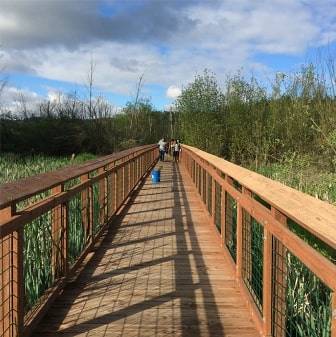From West Valley Highway, the paths are hard to pick out in the first weeds and brush — indeed, they take fixed shape only when you are hundreds of yards inside the Auburn Environmental Park.
As for the homeless encampments the paths lead to, there is nothing subtle about them, littered with used hypodermic needles, feces, urine in jugs in the creek and in the wetlands, with garbage, food waste, batteries, electronics, plastics, kids toys, chairs all around.
In the last six months, this problem has grown.
As of March 29, the city of Auburn had identified 43 encampments in the Auburn Environmental Park, 413 Western St. NW. Some of the encampments have people living in them, some are empty, 41 of them a-glint with used needles. Sometimes there are small children living in the encampments.
On March 29, Community Development Director Jeff Tate described to the Auburn City Council the problems all of that human habitation is causing the park, including the growing degradation of the environment, which costs the city and its taxpayers a lot of money in cleanup.
That includes the removal of debris from wet areas that would otherwise find its way into water channels on other parts of the wetland, sink into the soil and finally descend into aquifers far below. None of the junk can be carted off in trucks, Tate said, because trucks aren’t allowed in the park. It all has to wheel-barrowed out, or bagged up and carried out.
Tate said the city discovered the first encampment months ago in an area between West Valley Highway and State Route 167, a tract that includes wetlands, Mill Creek, and upland areas that create islands within the wetlands. Mill Creek is a salmon-bearing creek, earning it unique environmental attention from the city.
“The AEP is something that the city has spent a lot of money on,” Tate said of the park. “Acquisition of the property cost a lot of money, our protection efforts cost a lot of money, and those include mitigation and enhancement that we, along with our partner agencies, have designed and implemented to try to restore the environmental park.”
Before the highway was built, most of the land that makes up the park west of downtown was farmland with a smattering of homes. But the advent of State Route 167 in the late 1960s and early 1970s, and other construction projects that drained their runoff into the tract, made it a wetland unsuitable to farm or live on, occasioning at least one lawsuit.
Over the last 15 years, Tate said, the city of Auburn has invested a lot in the Auburn Environmental Park, first acquiring the property, then protecting it and adding amenities, among them a viewing tower, fencing and a boardwalk, Tate said.
The AEP encompasses land on both sides of the State Route 167 corridor, extending on the south end to West Main Street, and on the north end to 15th Street Northwest. On the north side of 15th Street Northwest, there is additional city property that is connected hydro-logically to the park.
“Environmental degradation is a concern of ours in this area, and we have not only a desire to clean and improve the conditions back there from an environmental perspective, but we also have regulatory obligations to make sure that these areas are clean,” Tate said.
What brought the subject to the council’s attention last Monday was that six months earlier, the council had adopted an ordinance against camping on city-owned property, and now it is considering whether to create an appeal process for people caught in the act.
Tate was not even halfway through his presentation Monday when undefined technical issues forced the city to table the meeting until 5:30 p.m. April 5.


